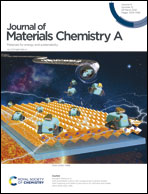A biopolymer-based functional separator for stable Li metal batteries with an additive-free commercial electrolyte†
Abstract
Lithium (Li) metal is an ideal anode material for next-generation batteries. However, the commercialization of Li metal-based batteries is impeded by uncontrollable Li dendrite formation and the accumulation of a solid-electrolyte interphase (SEI). Recently, various polymers have been investigated to form a stable SEI layer on Li metal and extend its cycle life. In this study, a polymer film composed of sodium alginate (Na-Alg), which is a natural biopolymer obtained from brown algae, and poly(ethylene oxide) (PEO), was used as a separator. Na-Alg sustained the film structure and PEO facilitated Li-ion diffusion by absorbing the liquid electrolyte. Without using any additives in the commercial carbonate electrolyte, this method extended the cycle life of a Li metal symmetric cell to 1000 h with an overpotential <10 mV, and the cycle life of a full-cell (LiNi0.6Co0.2Mn0.2O2 cathode) to 200 cycles. This study suggests that the use of a biopolymer may enable the practical use of Li metal in next-generation batteries.



 Please wait while we load your content...
Please wait while we load your content...